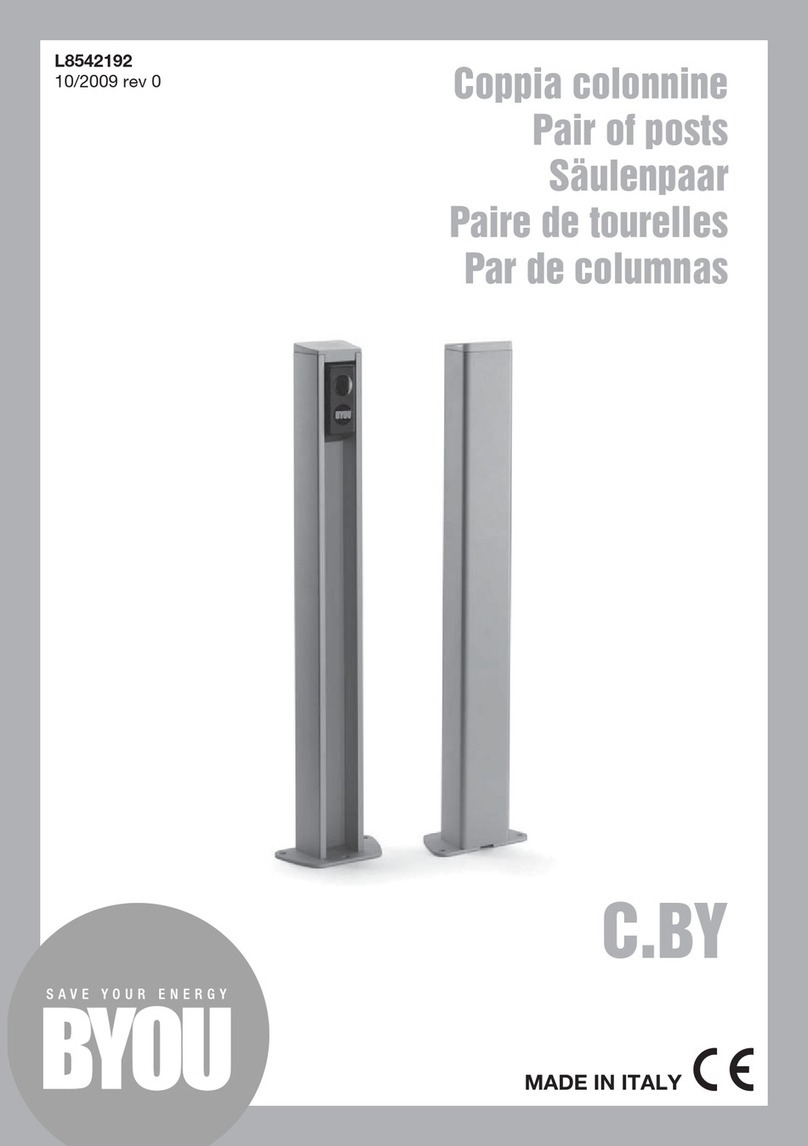
3
General recommendations
WARNING: Important safety instructions. Follow all
instructions since incorrect installation can lead to
severe injury.
f this is the first time you realise an automation for swing
gates with Beauty, we recommend that you read this manual
carefully as it contains important advice and information for
the realisation of the plant in safe conditions.
Keep the various components on hand to gain confidence
with them while reading this manual.
Keep this manual for future use.
BEAUTY is realised in a way to allow easy installation and
configuration of the system, however, some phases require
the presence of qualified staff.
When reading this manual pay particular attention to these
symbols:
Authorised technician.
Indicates the phases to be performed in the pres-
ence of mains voltage. The presence of qualified
staff is required (electrician or authorised installer),
in complete respect with the Safety Standards in
force.
Attention!
Potentially dangerous operations. Scrupulously
respect the indications given.
Useful indication.
Suggestions and recommendations for simplifying
and/or improving the installation operations.
The automation of a door cannot be considered the only
device for protection against intrusion.
Do not use any of the components in unsuitable environ-
ments (salty, acid or potentially explosive atmosphere)
All operations that require the protection shells of the
devices opened, must take place without mains power
supply.
This item is not intended to be used by people (including
children) with reduced physical, sensorial or mental abili-
ties, or without adequate knowledge of the product, unless
they are under the supervision of eligible persons or they
have received instructions for use by people in charge of
their security.
Check that the temperature range marked on the drive is
suitable for the location.
The drive cannot be used with a driven part incorporating a
wicket door (unless the drive cannot be operated with the
wicket door open).
Ensure that entrapment between the driven part and the
surrounding fixed parts due to the opening movement of
the driven part is avoided.
After installation, ensure that the mechanism is properly
adjusted and that the protection system and any manual
release function correctly.
DESTINATION OF USE
This product is destined exclusively for the opening and
closure of swing doors for the passage of vehicles, charac-
terised by dimensional limits and weight as indicated in this
manual in the “Limits of use” paragraph.
No other use is allowed.
BYOU is not liable for uses that are not in compliance with
those indicated in these instructions.
The kit is made up from two electromechanical operators
with 24V direct current motor, which allows movement of
the leaves via a worm screw.
The control unit commands the movement of the two motors
and the functioning of the various accessories.
The supplied accessories are:
- 1 P.BY pair of photocells: they interrupt the movement of
the leaf if there are obstacles present.
- 1 F.BY flashing light: flashing light that indicates that the
door is moving.
- 1 K.BY key selector switch: installed externally, allows the
opening and closure by means of a customised key.
- 2 BY radio transmitters: remote control for opening/clos-
ing the door.
Other accessories available as options:
- CB.BY emergency battery kit: in case of a power cut, it
allows the functioning of the leaf by batteries and relative
battery charger installed inside the operator.
- C.BY pair of small columns for additional pair of photo-
cells F.BY: to be installed within the property (see para-
graph C.BY).
Product description





























